The Spanish Line
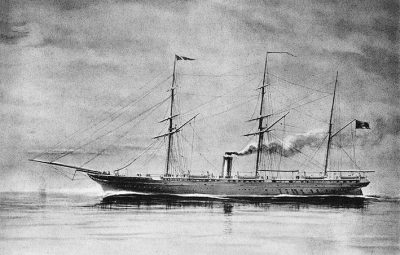
The Spanish Line was the premier overseas passenger line of Spain and lasted for a period of 162 years from 1850. The history can be traced back to the late 1820s and 1830s when Antonio Lopez y Lopez emigrated to Cuba at the age of twelve years. He had been born in 1817 in the small town of Comillas near Santander, and was followed to Cuba by his brother Claudio. He began trading in dry goods, and made a small fortune, then in 1850 the brothers began shipping dry goods, sugar, rum and molasses around the coast from Santiago and Guantanamo into Havana Bay past the 16th century El Morro fortress. The vessels used were the wooden screw steamer General Armero of 716 tonnes displacement and the wooden paddle steamer Botafuego of 143 grt. The brothers then returned to Alicante in 1856 to set up a shipping company, Antonio Lopez y Compania, which began an Alicante to Marseille passenger service with three small Denny built ships, Madrid of 715 grt, Alicante of 604grt, and Marsella of 715 grt, to connect with newly opened railway lines.
The ambition of the brothers was to start a Transatlantic passenger service, and in 1861 they were awarded a contract by the Spanish Government to carry passengers and mail from Cadiz to Havana, San Juan on Puerto Rico, and Santo Domingo on Hispaniola. They needed well founded passenger liners suitable for long ocean voyages, and placed orders for three ships with William Denny at Dumbarton. However, the service was to begin in early 1862, and they were forced to purchase nine second hand steamers to begin the service while awaiting the new ships. This trio of iron hulled three masted steamers of 1,950 grt would be equipped with four tubular boilers and direct acting steam engines to give a service speed of twelve knots.
The trio were barque rigged and able to carry two hundred First Class and fifty Second Class passengers. The first pair were delivered in May and September 1863 as Principe Alfonso and Infanta Isabel at a cost of £103,180 for the pair, including deduction of a penalty of £1,250 for late delivery by the shipbuilder and for deficiencies in the spare gear and engines. There was a profit of £2,075 for the shipbuilder, who launched the third ship as A. Lopez on 21st November 1865, all of the trio having dimensions of length 282.0 feet and moulded beam of 38.5 feet. The design of the third vessel was altered to halve her cargo spaces in order to carry 620 steerage passengers.
The service prospered as the trio were equipped with two 32 pounder guns as a precaution against pirates in the Caribbean. The next ship was completed as Mendez Nunez in December 1870 by Robert Napier at Glasgow, and was fifteen feet longer than the original trio and of 2,331 grt. Similar sized ships were built by Oswald and by Pile on the Wear and by Dudgeon on the Thames in 1872. The next pair of Clyde built ships were completed in 1875 and 1878 and marked a step up in size to just over 3,000 grt as Alfonso XII, the then King of Spain who reigned between 1874 and 1885, and Ciudad de Cadiz.
The company moved its base from Alicante to Barcelona in 1881 and changed its name to a limited company, Compania Trasatlantica S.A. However, expansion plans for a service to Manila in the Philippines, where Antonio Lopez also had interests, had to be put on hold as the award of the Eastern Royal Mail contract went to their business rival, the Marques de Campo, a wealthy banker. The latter owned no ships, but quickly purchased British India Line and Castle Line passenger liners to establish the eastern route via the Suez Canal.
Antonio Lopez had been given the title of Marquess de Comillas in 1878, and to avoid using Marques de Campo ships he founded the Compania General de Tabacos de Filipinos in November 1881 to transport cargo home from the Philippines. However, after four years of heavy losses, the Marques de Campo was forced to sell his fleet to Claudio Lopez Bru (1853-1925), second son of Antonio Lopez, who had died in January 1883 of pneumonia. The first son of the founder had also already died, the founder having married Lluisa Bru y Lassus.
Claudio Lopez Bru inherited the title of Marques de Comillas in 1883 and all of the business interests of his father, and then began building up the fleet, purchasing eighteen vessels in 1884, including seven from the bankrupt Marques de Campo fleet. The company now held the mail contracts to Cuba, Puerto Rico, Santo Domingo and the Philippines. A new service to Central and South America was begun in 1886, with Antonio Lopez 3,460/81 as the first company ship with a steel hull and the first with electricity for lighting when completed by Denny in 1887.
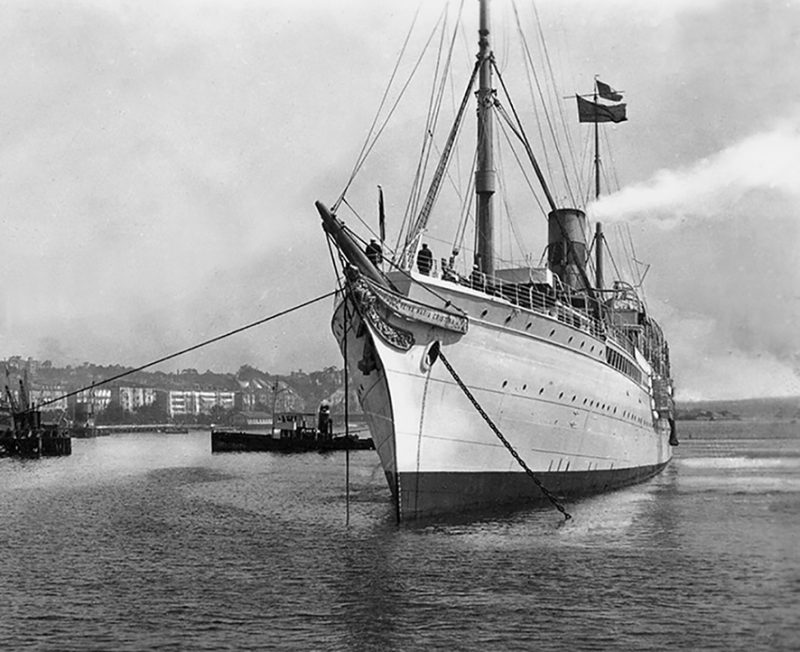
British yards then completed five fine new passenger liners for the Spanish Line during 1887/89, including the twin funnelled Alfonso XII (2) from the Wigham Richardson yard on the Tyne, and the single funnelled Alfonso XIII (who reigned between 1886 and 1931), Reina Maria Cristina, Monte Video and Buenos Aires. Some vessels of this quintet had great longevity, with Monte Video and Buenos Aires lasting 52 years before going to the breakers yards in 1940. Reina Maria Cristina was the exact twin of Alfonso XIII and named for the wife of King Alfonso XII, who after his death was known as ‘The Happy Widow’. This ship became a white hulled cruise ship in 1926 with her masts now reduced to two only, and along with the cruise ship Manuel Arnus, brought American tourists from New York to Seville to include visits to the great attractions of Madrid, Toledo, El Escorial, Granada and Cordoba. The cruise ships were given yellow funnels with two red bands and not too dissimilar to Compania Trasmediterranea. The Caribbean services were extended to Mexico in the 1890s, and a feeder service was begun between Havana and New York. By 1894, the company had a big fleet of 33 vessels of 93,500 grt engaged on Transatlantic services.

Spanish-American War Of 1898
Uprisings or, depending on your point of view, wars of independence in Cuba and the Philippines during 1895/96 saw the company charter or purchase ten passenger ships under contract to the Spanish Government for use as troopships. Good quality British and German passenger liners came from the fleets of Cunard Line, White Star Line, Shaw Savill & Albion Co. Ltd., British India Line, Paddy Henderson, New Zealand Shipping Company, Elder, Dempster, and Hamburg Amerika Line. The Spanish Line lost five passenger liners during the short three month long Spanish-American War of 1898. U.S. warships destroyed Antonio Lopez off San Juan (Puerto Rico), the Tyne-built Alfonso XII off Mariel in Cuba, Santo Domingo off the south coast of Cuba, Isla de Mindanao at Cavite (Manila), while the Panama was lost on the first day of the war as she approached Cuba from New York. The full list of 21 company ships that served to try to beat the blockade of American warships in the Caribbean and Pacific, with varying success was:-
| Montserrat | 4,147/89 |
| Alfonso XII | 5,063/88 |
| Antonio Lopez | 3,460/81 |
| Isla de Mindanao | 4,195/81 |
| Santo Domingo | 2,911/77 |
| Panama | 2,085/75 |
| Reina Maria Cristina | 4,818/89 |
| Alfonso XIII | 4,818/89 |
| Ciudad de Cadiz | 3,084/78 |
| Alicante | 4,031/89 |
| Monte Video | 5,205/89 |
| San Agustin | 2,359/82 |
| Rapido | 7,241/89 (chartered) |
| Patriota | 8,810/90 (chartered) |
| Isla de Panay | 3,545/82 |
| Covadonga | 5,031/84 |
| Colon | 5,026/84 |
| Isla de Luzon | 4,256/81 |
| Buenos Aires | 5,195/87 |
| San Francisco | 2,635/82 |
| P. de Satrustegui | 4,713/90 |
| Leon XIII | 5,087/88 |
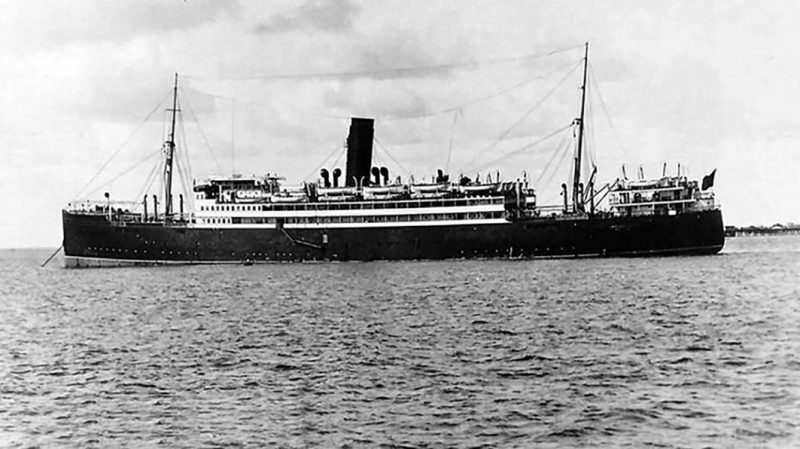
The last eight ships in the above list formed part of the squadron of Admiral Camara that sailed from Cadiz for the Philippines to help with the situation there, but were ordered to return to Spain after crossing through the Suez Canal after the armistice was signed with the U.S.A. The vessel Antonio Lopez was one of the more important blockade runners during the war, delivering vitally needed supplies of food and military supplies and arms to San Juan in Puerto Rico until she was grounded on 28th June 1898 under fire from the Americans. On that day, two American cruisers fought with a squadron of Spanish warships consisting of two cruisers, two gunboats and the Antonio Lopez. The latter ship was pursued by the American cruiser Yosemite and ran aground at Ensenada Honda near Dorado on Puerto Rico. Claudio Lopez Bru had sent a telegram to the Master of Antonio Lopez, saying ‘You must get your cargo ashore even if your ship were lost’. Thus, Capt. Ramon Acha Caamano was placed in charge of retrieving the ship’s cargo, and the men under his command quickly removed as much of the stranded steamer’s cargo as possible, saving nearly all of the cargo and losing only one cannon and some supplies overboard during the salvage attempts. The wreck today lies in 520 metres of water and was designated as a National Historic Landmark in 1997.
The Spanish-American War was the first war fought by the U.S.A. since the war with Mexico in 1847, with America victorious and Mexico losing enormous tracts of land to the north of the Rio Grande and Gila rivers that form four American States today and parts of three more. The two wars had strikingly similar characteristics in short, aggressive and muddled wars for territorial gain. At sea, it was a short, bloody and businesslike war with new American warships effortlessly crushing Spanish warships and merchantmen. Manila was seized when Commodore George Dewey of the U.S. Navy sank or disabled the inferior squadron of Far East Spanish cruisers. In the Caribbean, an American expeditionary force landed in Cuba and inflicted a tactical defeat at the Battle of San Juan Hill on 1st July 1898. The battle led to a stalemate on land with the Spanish and American forces losing more men to disease than in battle.
Another crushing American victory soon followed at the Battle of Santiago Bay off the Cuban coast on 3rd July 1898, with Spanish forces inside Santiago surrendering two weeks later. This was the end of Spanish colonial possessions in the Caribbean and the Pacific, and in the subsequent peace treaty signed in Paris, Spain granted independence to Cuba, while the U.S.A. took Puerto Rico, Guam and the Philippines in the Far East. Thus, the fleet requirements of the Compania Trasatlantica were drastically reduced, with many ships sold off to give a fleet of 26 ships of 73,000 grt by the end of 1899, a drop of nearly a quarter from five years earlier.
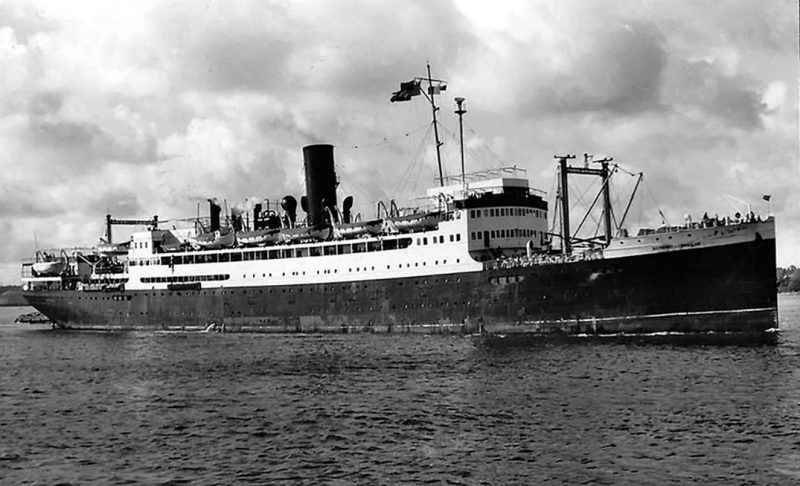

A New Century
A fine pair of passenger liners was then purchased from North German Lloyd in the twin funnelled Havel renamed Alfonso XII (3), and the Tyne built H.H. Meier renamed Manuel Calvo. Regular sailings were begun in 1900 from Genoa, Naples and Spanish ports to New York to increase passenger numbers. The fleet on the outbreak of World War I was 25 ships strong, including two new impressive liners of 10,300 grt completed in 1913 as Reina Victoria Eugenia on the Tyne by Swan, Hunter and Wigham Richardson Ltd., and her near sister Infanta Isabel de Bourbon from the Denny yard. This pair had many decks for 426 First Class and Cabin Class passengers and 1,640 emigrants in steerage, but there were differences in detail between the pair, the Denny ship had a smaller funnel and other deck gear differences, together with variations on their combined triple expansion and steam turbine machinery, which gave service speeds of seventeen knots. Their beautifully decorated public rooms made this pair of liners very popular on the South American route, and on the suspension of the monarchy in 1931, they were renamed Argentina and Uruguay before being laid up at the end of 1932.
Four ships were lost by shipwreck during World War I, and a veteran liner was purchased as a replacement. She was the twin funnelled former Scot built in 1890 for Union Lines services to Cape Town. She was then acquired by Hamburg Amerika Line and cruised as Oceana with a white hull until purchased in 1916 and renamed Alfonso XIII (2) for the route to the Caribbean and New York. She was renamed Vasco Nunez de Balboa in 1923 and broken up in Italy in 1927.
A further six new big passenger liners had joined the Spanish Line by 1928 from the yards of Sociedad Espanola de Construccion Naval at Bilbao, Cadiz, Cartagena and Ferrol, the smallest being Manuel Arnus of 7,538 grt completed in 1923. She was a smaller edition of two single funnelled liners of 10,800 grt completed later that year as Cristobal Colon and Alfonso XIII (3), with accommodation for 1,100 passengers in three classes plus 1,500 steerage passengers down below. A trio of similar twin screw twin funnelled liners of 9,900 grt was completed in 1928 as Juan Sebastian Elcano, Magallanes and Marques de Comillas. The first pair were named after leaders of the Spanish expedition in 1519 to find a route westward to the Spice Islands. Magellan was killed in the Philippines, and Juan Sebastian Elcano and his men then became the first to circumnavigate the world on their return to Spain in 1521. The trio had accommodation for 587 passengers in three classes and one thousand steerage passengers down below on the Caribbean service with calls at New York.

Spanish Civil War
The start of this three year very bloody war in July 1936 saw almost all of the company ships immediately laid up at Bilbao, Havana or ports in Mexico. Several liners were moved to the relative safety of the natural harbour of Mahon on Menorca, where Lord Nelson and Lord Collingwood had homes during the previous century. All passenger services were suspended until the war was over in 1939. Cristobal Colon was lost on a reef near Bermuda on 25th October 1936 while under the control of the Spanish Republican Government after sailing from Cardiff for Vera Cruz to load armaments. This fine liner split in two parts with her bow detached from the rest of the ship and eventually broke up. Many of their fine passenger liners were sunk, including the last British built pair of Argentina and Uruguay of 1913, lost by air attack while laid up at Barcelona in January 1939. Others such as Juan Sebastian Elcano were interned by Russia in the Black Sea and never returned, with another interned at Istanbul while transporting Russian armaments to support the loyalist Republican side of the conflict against the Nationalists led by General Francisco Franco.
World War II
Spain was neutral during this war, but still gave tacit approval to Fascist Germany, particularly at Algeciras where a tanker was secretly allowed to continue midget submarine operations against British shipping in Gibraltar for much of the war, and German spies were able to report British naval movements by radio to Berlin from the Reina Cristina Hotel. The Caribbean and New York route was operated by the pre-war sisters Magallanes and Marques de Comillas, their sister Habana having been gutted by fire at Bilbao and was rebuilt as a cargo ship with accommodation for only a dozen passengers. The other passenger liners of Buenos Aires, Monte Video, Antonio Lopez and Manuel Calvo were now unsuitable for passenger carrying due to their age and their three years of idleness during the Spanish Civil War. Manuel Calvo was the only one of this quartet to survive past 1946 after conversion to a cargo ship, not being broken up until 1958.
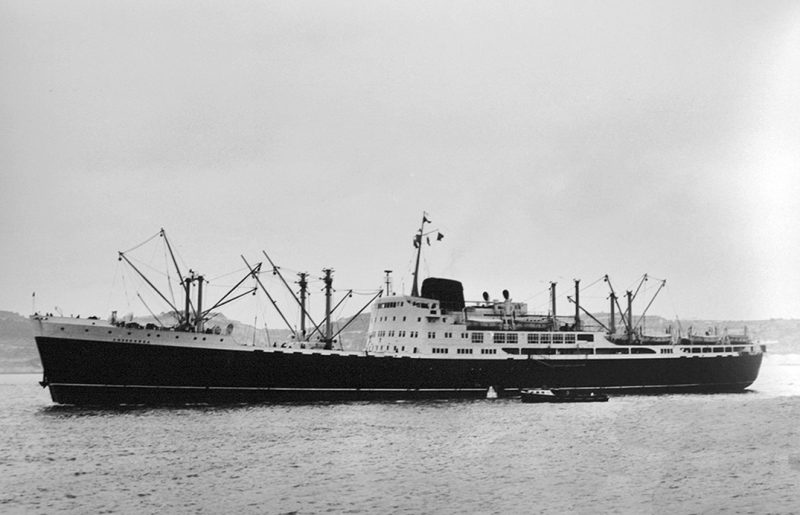
Marques de Comillas arrived at New York for the first time during World War II in November 1939, having called first at Havana. Magallanes arrived for the first time at New York during World War II in July 1940, and the two sisters continued this pattern of voyages until the entry of the United States into the war in December 1941. There had been no shortage of passengers as very few passenger liners were operating out of the Mediterranean to New York, carrying political refugees and others fleeing from Fascist brutality. Sailings were suspended for two months after the attack on Pearl Harbour by Japanese dive bombers, although sailing schedules by the two sisters were never published. Magallanes called at Havana and New Orleans in October 1942 with refugees as well as U.S. diplomatic personnel and citizens who had been stranded in Europe when the United States had fully entered the war.
Post-War Years
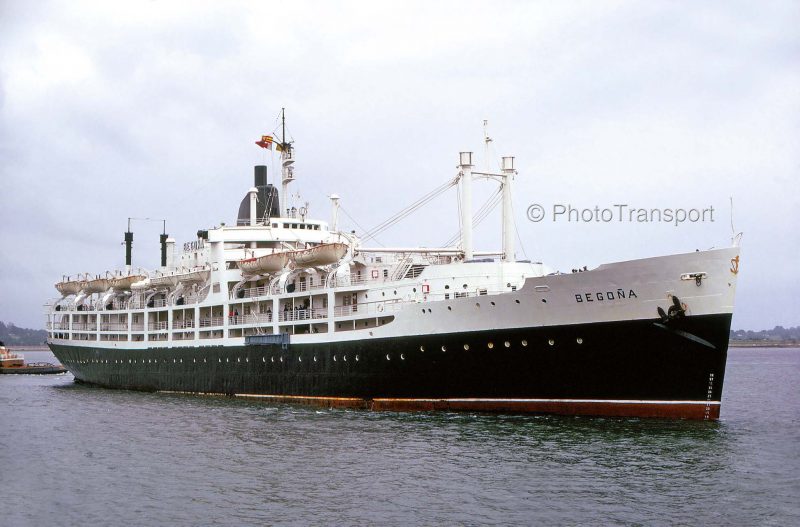
The former liner Habana was rebuilt with passenger accommodation for 107 passengers in 1946 by the Todd yard in Brooklyn, and joined her two sisters of Magallanes and Marques de Comillas after their post-war refits in July 1946 in published schedules to Havana and New York. However, it soon became clear that the combined passenger capacity of the three liners was insufficient for demand. Two standard ‘Monasterio’ design vessels were then purchased from the State owned Elcano fleet while still on the stocks and were completed as Covadonga and Guadalupe. They could be distinguished and identified apart as the Promenade Deck of Covadonga extended almost to her stern, whereas Guadalupe had a separate aft deck house. They had accommodation for 105 First Class passengers and 248 Tourist Class passengers, and also carried large amounts of cargo across to Havana, Vera Cruz and San Juan (Puerto Rico) either on the outward or homeward voyages. They sailed from Bilbao, Santander, Gijon, Vigo, and Lisbon to Havana, Vera Cruz, San Juan, New York, and returned to La Coruna, Santander and Bilbao.
Magallanes was laid up in 1954 and broken up three years later, and her sister Marques de Comillas continued in service until the last month of the decade. She was then laid up but caught fire at El Ferrol in November 1961 and was then broken up. Two converted ‘Victory’ ships were then purchased from Sitmar Line for $9 million in 1957 for service from Italy and Spain with emigrants to the Caribbean and Venezuela, returning with Jamaican emigrants to Southampton.
Begona and Montserrat had accommodation for 939 and 822 passengers respectively, Begona having an extra deck, and both made initial voyages with emigrants to Australia in 1958. They continued in service until both suffered serious mechanical breakdowns resulting in their withdrawal for breaking up in 1973/74.
A further pair of smaller passenger liner twin screw sisters of 6,518 grt began a service in 1952 from Barcelona, Genoa and Cadiz to Tenerife, San Juan, Ciudad Trujillo, La Guaira, Caracas, Barranquilla, Havana, New Orleans, Puerto Plata and return to Spanish ports. They were named Satrustegui and Virginia de Churruca (after the company president’s mother) after purchase when four years old after their completion by the Union Navale de Levante yard at Valencia in 1948. They had accommodation for 222 passengers (65 First Class, 54 Cabin Class, and 83 in Tourist Class) and service speeds of sixteen knots from B & W diesels. This pair of liners were taken out of service at the end of 1972 and sold to Trasmediterranea. Thus, passenger sailings by the great Spanish Line ended in 1974, with Covadonga sailing for the last time from Bilbao on 3rd December 1972, and her sister Guadalupe on 5th January 1973, while those of Montserrat and Begona ended in early 1973 and October 1974 respectively.
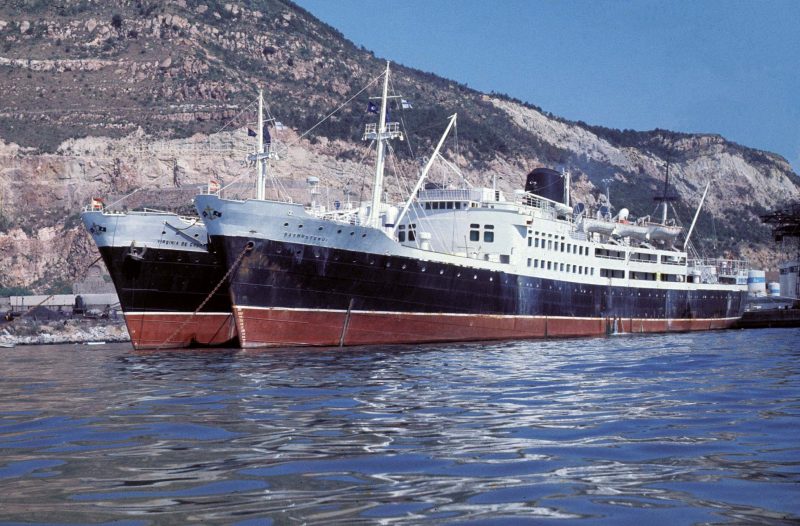
Cargo services between the Western Mediterranean and Central America had begun in 1960 with the engines aft Almudena of 5,355 dwt, and continued for four more decades. Ten engines aft cargo ships of between 5,300 dwt and 8,245 dwt named Almudena, Ruisenada, Comillas, Coromoto, Camino, Merced, Galeona, Roncevalles, Valvanuz and Belen carried between twenty and fifty containers on their decks. They were followed by two part container ships, and two cellular container ships, Covadonga (ex Kanimbla) and Guadalupe I (ex Manoora) of 14,894 dwt and 900 TEU capacity with a service speed of 17.5 knots from 11,200 bhp Sulzer diesel engines, the latter pair purchased from Australian owners in 1980 for these routes. Two larger container ships were completed by Astilleros Espanoles at Cadiz as Pilar and Almudena of 18,210 grt and 1,552 TEU capacity for the company in early 1982. This last pair had four cellular holds served by eight hatches, with a good turn of speed of twenty knots from seven cylinder two stroke B & W diesel engines of 23,900 bhp manufactured at Valencia.
However, in April 1994 the company and these four container ships were sold to Naviera del Odel of Madrid to double the size of their Odel container ship fleet until the end of their charters from 1985 onwards. The company had officially had the suffix ‘Espanola’ added to its title in 1953 to become Compania Trasatlantica Espanola, and managed to survive as a separate entity under this title after 1994 with minor shipping operations using chartered ships and in the real estate business until September 2012, when it entered insolvency practices.
Postscript
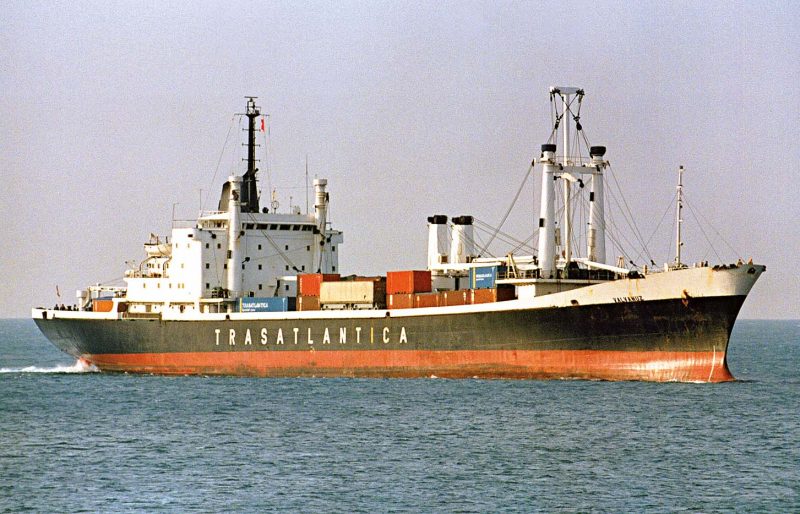
The Spanish Line has had several important sculptures and buildings to celebrate its name by well known sculptors and architects, including the Catalan architect Antonio Gaudi, famous in Barcelona for many fine buildings, the colourful Parque Guell, and the cathedral of Sagrada Familia, now only a few years away from final completion. Gaudi built the company pavilion for the 1888 Universal Exhibition in Barcelona, which lasted intact for a good few years after the exhibition before demolition to make way for the current harbour promenade near the well know tall landmark to the great Spanish navigator and explorer Cristoforo Columbus.
In Cadiz, there is a very fine tall monument to the company and Don Claudio Lopez Bru, Second Marques of Comillas. It is located in the Alameda Square next to the Church of Carmen, and on its base they are two figureheads of ships above which are sculptures of a lion and a condor, symbols of Europe and America. There is a bust of Don Claudio Bru, shipowner with a long relationship with the maritime life of Cadiz, and at its top there is a sculpture of a mother and child, symbolic of the maternal union between Spain and the American continent. The tall monument is decorated all over the central column by shields and medallions, and was the work of Catalan sculptor Antonio Parera and was completed and installed in 1922.

In Barcelona, where the company and its agents were based for most of their existence, there is a sculptural bas relief panel on one side of the monument to Antonio Lopez y Lopez, First Marques de Comillas. This is by the Catalan sculptor Rossend Nobas, and features a mother and child, with the mother holding a small anchor, and is also decorated with shields and medallions. Certainly, The Spanish Line will never be forgotten in Spain.
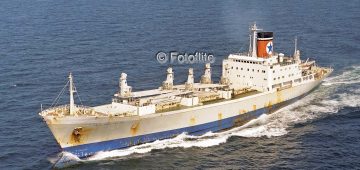



Comments
Sorry, comments are closed for this item